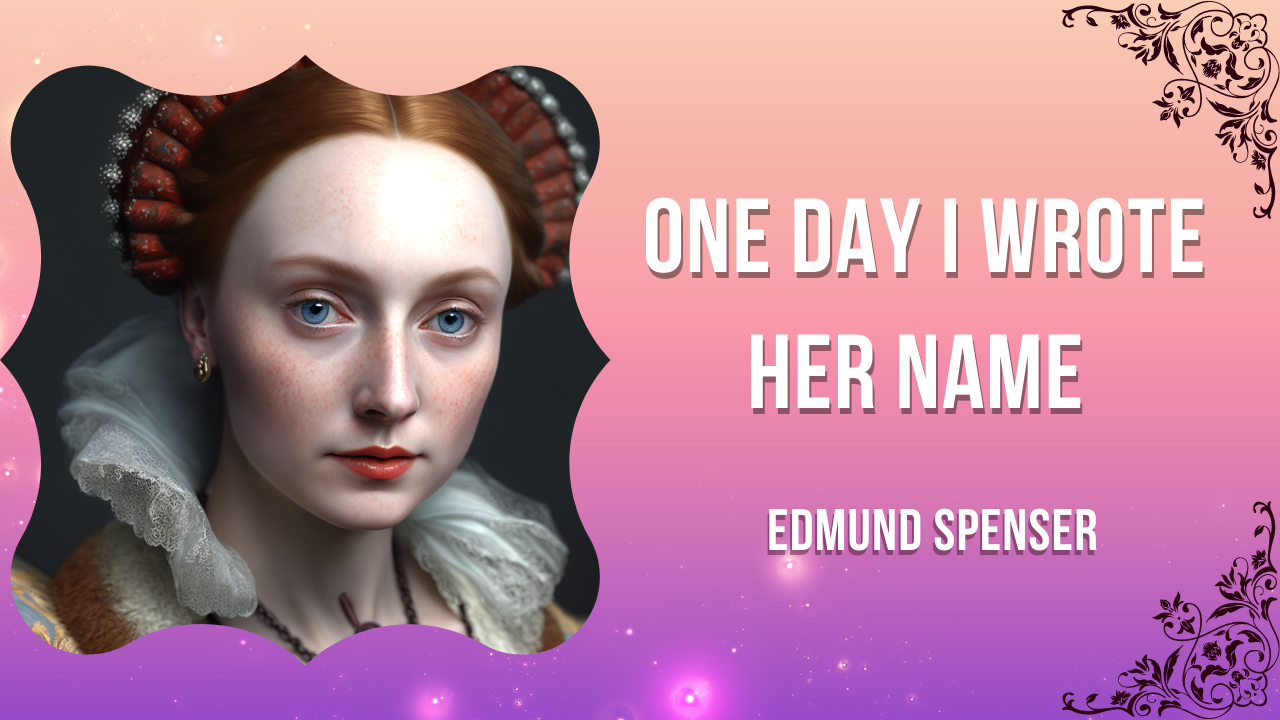Amoretti LXXV: One Day I Wrote her Name By Edmund Spenser Analysis
Introduction
Edmund Spenser is widely recognised for his contribution to English Renaissance poetry. The sonnet “One Day I Wrote Her Name Upon the Strand,” first published in 1595, is one of his most famous works. This poem is widely considered to be a classic example of Elizabethan love poetry. The poem is written in the traditional Shakespearean sonnet form, with three quatrains followed by a couplet at the end. The poem’s themes of love, transience, and mortality are found in many works of Renaissance literature.

Amoretti LXXV: One Day I Wrote her Name
By Edmund Spenser
One day I wrote her name upon the strand,
But came the waves and washed it away:
Again I wrote it with a second hand,
But came the tide, and made my pains his prey.
“Vain man,” said she, “that dost in vain assay,
A mortal thing so to immortalize;
For I myself shall like to this decay,
And eke my name be wiped out likewise.”
“Not so,” (quod I) “let baser things devise
To die in dust, but you shall live by fame:
My verse your vertues rare shall eternize,
And in the heavens write your glorious name:
Where whenas death shall all the world subdue,
Our love shall live, and later life renew.”
Analysis
The poem is about the ephemeral nature of love and the inevitability of death. The speaker writes his lover’s name in the sand, but the waves wash it away, symbolising the transience of life and love. The speaker introduces the theme of transience in the first quatrain by saying that he wrote his lover’s name on the sand, but the waves washed it away. He then compares this to how time erases everything, including great men’s achievements.
The speaker focuses on his lover’s beauty in the second quatrain, describing her as “fair” and “sweet.” However, he recognises that her beauty, like all things, is subject to decay and will be lost to time. The word “miracle” is used specifically in line 5, implying that the speaker is aware of the fleeting nature of his lover’s beauty.
The speaker reflects on the inevitability of death in the third quatrain. He claims that the only certain thing in life is death, and that even the most powerful and wealthy people cannot avoid it. In line 10, the phrase “proud and silly” implies that the speaker believes that those who are overly concerned with worldly success are foolish, as they will eventually meet the same fate as everyone else.
The speaker offers a solution to the problem of transience and mortality in the final couplet. He claims that by immortalising his lover’s name in his poetry, he can ensure that her memory lives on even after she dies. The word “living” in the final line is significant because it implies that the speaker believes that by writing poetry, he can keep his lover’s memory alive.
Overall, the poem is a contemplation on the transience of life and love, as well as the inevitability of death. Everything, even the most beautiful and powerful things, are subject to decay and eventual loss, according to the speaker. He also implies that by immortalising his lover’s memory in his poetry, he can transcend the limitations of mortality and create something that will live on after he and his lover are gone.

Themes
The poem addresses a number of issues, including the transience of love and the inevitability of death. The speaker is writing about his lover and his feelings for her, so the theme of love is central to the poem. The poem does, however, acknowledge that love, like everything else, is subject to decay and loss. The theme of mortality is also central to the poem, as the speaker considers the fact that everything, including the most powerful and wealthy people, will die at some point.
The poem also addresses the theme of transience, which is intertwined with the themes of love and mortality. The image of the waves washing away the name written on the sand is a powerful metaphor for the transience of life and love. Everything, including love and life itself, is subject to the passage of time and the inevitability of change, according to the poem.
The poem concludes with the theme of immortality. The speaker suggests that by immortalising his lover’s memory in his poetry, he can transcend mortality and create something that will live on after he and his lover are gone. This theme implies that there is a way, at least in some small way, to overcome the inevitability of mortality by creating something that will last beyond the individual’s lifetime.

Language and Literary Devices
The poem is written in the most common metre for English sonnets, iambic pentameter. This gives the poem a formal, structured feel that suits the serious themes it addresses. The poem also employs a number of literary devices, including alliteration, metaphor, and imagery, to enhance its meaning and paint a more vivid picture in the reader’s mind.
The speaker uses metaphor effectively in the poem, comparing the fleeting nature of life and love to something concrete and tangible, such as the waves washing away the name on the sand. This imprints a strong image in the reader’s mind, emphasising the transience of all things.
The poem’s use of imagery is also effective because it allows the speaker to describe his lover’s beauty and the passage of time in a vivid and memorable way. The image of the waves washing away the name on the sand is especially striking, emphasising the transience of life and love.
Conclusion
In conclusion, “One Day I Wrote Her Name Upon the Strand” is a classic example of Elizabethan love poetry that addresses themes of transience, mortality, and immortality. The poem is notable for its use of metaphor and imagery to paint a powerful and vivid picture of life and love’s fleeting nature. Although everything is subject to the passage of time and the inevitability of change, the poem suggests that it is possible to transcend the limitations of mortality by creating something that will last beyond the individual’s lifetime. The poem is considered a timeless classic of English Renaissance poetry because of its enduring themes and lyrical beauty.

